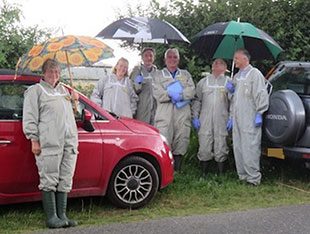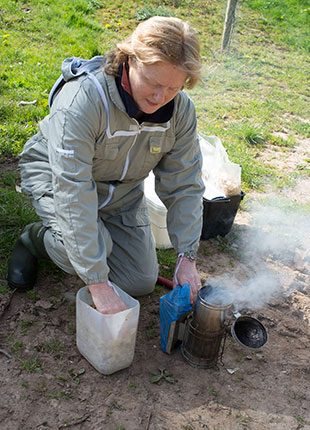ISO 17020 accreditation has been awarded to the APHA National Bee Unit. This is the first time a bee inspectorate has received this accreditation.
The ISO 17020 standard specifies the requirements for the competence of organisations performing inspections and the impartiality and consistency of their inspection activities. Find out more on the UKAS website.

Being the APHA project leader for ISO 17020 brings a lot of unusual and rewarding new experiences. Wearing a protective bee suit was definitely one of these!
Work on ISO 17020 started back in 2010 when APHA’s Plant Health and Seed Inspectorate (PHSI) was awarded accreditation by the UK accreditation body UKAS.
The scope of the activities covered quarantine plant pest import inspection work at seaports and airports and the control of pest transfer between plant nurseries through application of the EU plant passporting Directive.
I was tasked with expanding the scope of UKAS accreditation to cover the other areas of our inspection work, and the bee inspections organised through the National Bee Unit were next in line.
I started working with an APHA Regional Bee Inspector, Jo Schup, in August last year to formalise the process for notifiable disease detection, in relation to European and American Foulbrood diseases.
European and American Foulbrood are bacterial diseases affecting bee larvae and have the potential to seriously affect the honey bee population in Britain if they become established. Find out more on the National Bee Unit website.
Together we mapped out the end to end process of inspection, and supporting documentation was refreshed and simplified.

Having a record of the competence of inspection staff is a key element of the standard. With this in mind, the inspector training procedure was assessed and updated and training records for the inspectors formalised. A programme of witnessed inspections was also introduced, to ensure the on-going monitoring of this competence.
I accompanied bee inspectors to witness their work and ensure that the mapped out process mirrored what is actually carried out by bee inspectors in the field.
The work requires bee inspectors to break down the hives by removing the ‘supers’, where the honey is stored. Inspectors then look at the individual frames in the brood chamber where the queen lays its eggs and where the bees are raised from the grubs.

Foulbrood symptoms are identified through careful observation of the colour and texture of the topping material covering the brood chamber as well as signs of unusual development in the grubs plus the use of lateral flow field diagnostic kits. To observe this safely I had to wear a bee protection suit and be subjected to flying bees all around my face whilst the hives were dismantled and inspected. I tried to keep calm whilst this was happening, but it would have been very easy to panic!
The UKAS assessment of our notifiable disease inspection work took place in August of this year. Some minor issues were quickly resolved with UKAS and we are now delighted to report that ISO 17020 accreditation has been awarded to the National Bee Inspectorate. We believe this to be an international first and definitely deserving some celebration. This was a great team effort and thanks should go out to the staff in the NBU for their great commitment in obtaining this great goal.
If you would like further information on APHA’s ISO accreditation programme please contact David Galsworthy and Mike Brown for more information on the role of the National Bee Unit.
Follow APHA on Twitter and don't forget to sign up to email alerts.

Recent Comments